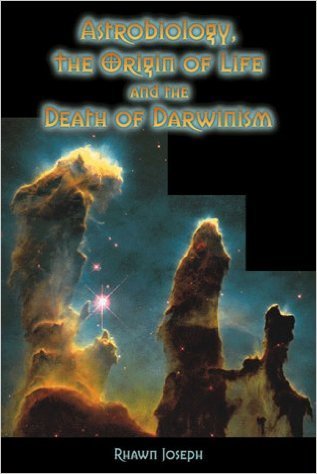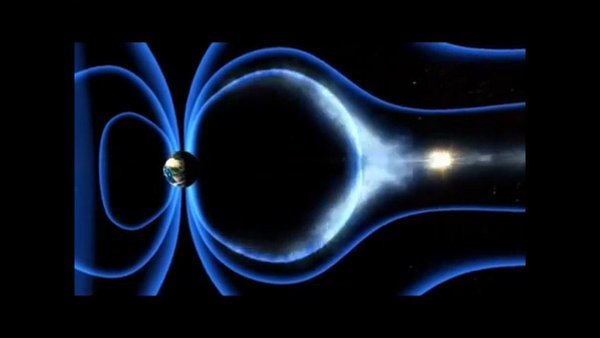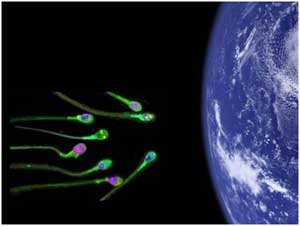The Death of Darwinism Part I: Behe’s 2nd and Joseph Too
Darwinism's assumption of random mutation fails; panspermia is part of the answer.
The infamous Michael Behe, author of “Darwin’s Black Box”, considered one of the cornerstones of Intellectual Design has out, after a decade hiatus^, a second book “The Edge of Evolution: The Search for the Limits of Darwinism”.
I’ve never read the ‘Black Box’ for a couple reasons. I heard that the gravamen of his claim was ‘irreducible complexity’. That didn’t really light my fire, and anyway, I already knew Darwin’s was, in its principal claim of random mutation, almost certainly wrong.
My favorite quirky science book is Rhawn Joseph’s “Astrobiology, the Origin of Life and the Death of Darwinism” (his website is also a hoot). As one might guess from the title, Darwin doesn’t survive Joseph. The Amazon reviews, many by credentialed people, are bi-polar, two-thirds 4-5 stars and one-third 1-2 stars.
Joseph is an eminent neuroscientist. Here’s an excerpt from his introduction to “Astrobiology”:
Nevertheless, in seeking to understand my findings, I turned to genetics. I found that plants and humans share genes that code for seeds and neurons, and determined that the human genome and the genome of the higher plants share homologous DNA-promoters and binding domains (e.g. da and AS-C), including a similar “helix-loop-helix” motif which is involved in cellular divisions and neuron generation in vertebrates, as well as the production of ovaries and seeds in plants via CHS-A and –J promoters. These shared plant/flavone human/neural transcription factors, promoters, and genes act to regulate genetic transcription and thus the activation of other genes including those specifying neural vs cellular differentiation and development.
Question: How did the same genes and promoters come to “evolve” in completely distinct species? The common ancestor for mammals and plants diverged between 1 and 2 billion years ago; almost 1 billion years before the evolution on Earth of neurons, seeds or sex organs. Indeed, estimates of the times of divergence between eubacteria and eukaryotes, between protists and other eukaryotes, and between plants, fungi, and animals are approximately 3 billion, 1.7 billion, and 1.3 billion years ago, respectively.
As will be detailed in later chapters, there are an incredible number of basically identical genes and identical proteins, which have seemingly independently “evolved’ in completely distinct species.
The Darwinists explain away these and other common genes and traits by evoking “coincidence” – that nature arrived at the same solution in different species by accident and thus created the same exact gene by random chance; which is absurd. [References omitted]
Although there are lots of ideas thrown out by Joseph, the core idea is panspermia and he comes to that conclusion primarily by looking at genetics. There is no way for DNA to have originated from clay on Earth as fast as it did (bacteria sign appears in some of the oldest rocks on Earth, meaning that microbes flourished from the moment the bombardment ended about 3.9 billion years ago), or at all, really. There is no precursor to DNA on Earth and there was no free oxygen or phosphorus (basic building blocks of DNA) on the pre-biotic Earth. And there is no way that life’s functions emerged from inanimate muck by random mutation on the smoking early Earth. So, the DNA tool box for life (in fact for building the entire ecosystem) just fell to Earth and was ready to go to work in any conditions it found itself in. Hey, DNA is a terraforming, eco-system building, niche-filling nano-machine.
Strange Facts Bearing on the Panspermia Idea
Tool box: One bacteria (amoeba dubia) has about 200 times more DNA than humans and another over 300 times as much. Sponges are the oldest known existing lineage of animals—at over 600 million years old. It turns out they are loaded with all sorts of genes that code for high animal forms and functions, but are pretty useless to a sponge.
From The Origin Of Animals And Disease Found On The Great Barrier Reef, Australia:
"Simple sea sponges have a genome of remarkable complexity," Professor Degnan said.
"It includes all of the gene families necessary for the development and functioning of complex animals, including humans and from this comparison we have been able to reconstruct the last common ancestor between humans and sponges."
The unanticipated and incredible sophistication of this 600+ million year ancestor rewrites all the textbooks and destroys long-held views that the very first animals were nothing but simple balls of cells.
Essentially all the genomic innovations that we deem necessary for intricate modern animal life have their origins far further back in time that anyone anticipated, predating the Cambrian explosion by tens, if not hundreds, of millions of years.
Um. Where the heck did all this DNA information come from? Doesn't leave much work for random mutation in evolution.
Strange Junkyard: Conventional thought is that most DNA is ‘junk’ (some large portion of DNA in humans in non-coding, that is, not part of a gene) [however, the ENCODE project is questioning whether there is much junk at all, to the consternation of neo-Darwinists: Is junk DNA all garbage?]. But junk DNA sequences have been found to be preserved in higher animals at least for over 400 million years. If the stuff was being randomly mutated, why would it be preserved? As Joseph points out, this is taken to absurdity by genes not used until literally millions of years later (or not at all, like sponges) appearing in beasts who’s common ancestry split billions of years ago. In other words, genes for specific purposes preceded these purposes by millions or billions of years. They did not randomly evolve in order to make an evolutionary leap.
Rarest of the Rare: In the book, “Rare Earth”, the authors list all of the unlikely things that happened in the history of the planet, but curiously, they don’t mention the evolution of DNA or the origin of life. They assume primitive life is ubiquitous in the Cosmos. However, they spend a lot of time pointing out the essential impossibility of the Cambrian Explosion and its aftermath [discussed in Part III], if Darwinism was true. So panspermia, though not mentioned in the book to my recollection, is there firmly between the lines.
Micronauts; Lots and Lots of Micronauts. The Earth could, and probably does, leave a long tail of life in its wake. Electromagnetic/magnetic fields could eject charged bacteria into outer space by the ton every day! Electrified bugs soar into space and infest the galaxy. The author suggests that a single life-bearing planet could seed the entire galaxy, probably within a few (or few tens of) million years. A first step will be to find signs of life on Mars.
In the 1970's Chranda Wickramasinghe determined that certain absorbtion spectra indicated that much cosmic 'dust' was consistent with desiccated bacteria. Although roundly ridiculed at the time, his findings have become conventional wisdom. From Wiki "From the early 1970s it was becoming evident that interstellar dust consisted of a large component of organic molecules."
Who’s Who. I think panspermia has gained much wider purchase within the science community than many would guess. Big names include Fred Hoyle, Thomas Gold and Chandra Wickramasinghe, but my guess is that most scientists that work in an area that touches on origins are open to Panspermia. NASA seems to accept something like panspermia. Whenever they talk of finding life, the only criterion they are looking for is liquid water.
Behe’s 2nd
So back to Behe. First, Behe is not arguing 6-day creationism, or that God did it. I’d guess he would be perfectly comfortable with panspermia. Behe points out Darwin’s scientific contributions with regard to common descent and natural selection. Behe also shows that random mutation is a force of nature. It is just a very limited force in the grand scheme of evolution.
In light of Joseph, what Behe has to say is obvious, but it is nice to see an elegant presentation of the science that pretty much nails the issue. The principal focus of “The Edge of Evolution” is that the first basic step in any Darwinist evolution would be to evolve new protein binding sites. In order to build anything, first proteins must be built and then bind to one another to build more complex structures. That is, random mutation must first begin by creating novel proteins that bind with other proteins in away that is beneficial and leads to building more complex structures. Behe shows that you just can’t get there with random mutation.
Behe uses the malaria parasite and HIV as his principle subjects. These two are Darwinist Super-Stars because they have large population sizes and rapid mutation rates. Hence, their ability to adapt and generate novel structures and functions by random mutation is the highest of any life forms on Earth. What he shows is that random mutation accomplishes next to nothing constructive. The fabled ability of malaria and HIV to develop drug resistance (and hailed as proof of Darwinist evolution) is almost always caused by breaking something, not building something. In other words, if you have a disease (like sickle-cell anemia), you have a defective gene that fouls up the proper function of a protein and makes you sick. But if it provides protection against a deadly disease, you have a better chance at survival, at least to reproduction. Behe shows that in essentially all cases, disease resistance to a drug is accomplished by degrading the genetic code (making something that works fine not work as well or at all), and the mutation typically is reversed when the drug is discontinued.
There are some good positive reviews on Amazon for Behe’s book. Here are excerpts from a couple.
From Stephen P. Smith:
From studies (where there is the most data) on malaria, HIV and E. coli, Behe is able to set a conservative estimate on what is possible for Darwinian evolution in a constructive sense (not just in a destructive sense) to build protein-protein interactions. Behe's conservative estimate is roughly matched against the likelihood of chloroquine resistance in malaria, otherwise no new protein-protein interactions have been found in drug resistance studies involving HIV or E. coli. Because of the astronomical numbers of malaria parasites, Behe (page 61) makes this projection: "No [random or undirected] mutation that is the same complexity as chloroquine resistance in malaria arose by Darwinian evolution in the line leading to humans in the past ten million years." Behe (page 146) writes: "The immediate, most important implication is that complexes with more that two different binding sites - ones that require three or more different kinds of proteins - are beyond the edge of evolution, past what is biologically reasonable to expect Darwinian evolution to have accomplished in all of life in all of the billion-year history of the world... With the criterion of [greater than] two protein-protein binding sites, we can quickly see why stupendously complex structures such as the cilium, the flagellum, and the machinery that builds them are beyond Darwinian evolution. The flagellum has dozens of proteins parts that specifically bind to each other; the cilium has hundreds."
And from the Professor:
After reading the many negative reviews of this book, I decided to read the book from cover to cover. I conclude that the negative reviews do not reflect the total contents of the book. Much of the material in this book is a review of the literature, which almost none of the critics found fault with. One can quibble with Behe's statistics, most of which he relied on those computed by others, but I have concluded that his main point is valid. I and others would find it very helpful if those who disagree with Behe's results to do their own calculations or refer us to the relevant literature. I have done similar calculations, only with mammals, and have concluded that combining mutational probability and the number of mammal life forms that have existed historically paints a far worse picture than Behe documents for bacteria. The number of uncorrected mutations compared with the number of mammals does not provide much hope that Darwinian mechanisms alone could provide the raw material to evolve mammals from their theoretical common ancestor. There are far to few mammals and far too few uncorrected mutations, most all of which, as has been well documented, are detrimental or, worse yet, near neutral. Many if not most mammals have historically, and today, existed in relatively small numbers. Ecologists have estimated how many Pandas, bears, big cats, and other mammals have ever existed, and the numbers are tiny compared to bacteria. The most successful mammals are the rodents and even their number is tiny compared to bacteria. I also found that many of the critical reviews of this book were just plain wrong. . .
What To Think?
Here are some conclusions I’ve drawn from all this:
Panspermia will prove to be correct. The latest Mars mission might get us a long way to demonstrating that statement.
The genetic code is far more sophisticated than imagined. However it came to be, DNA is terra-forming, eco-system building, highly-advanced nanotechnology. There must be a higher-level control program in there somewhere that no one has even thought to look for.
As the authors of Rare Earth propose, life will be everywhere in the Universe that it can get a foothold, and it will be DNA based life. It will do its best to build an eco-system that is Earth-like.
Wherever we go, their we'll be. In other words, if we become a space-faring people and visit other planets, they will be much like earth in flora and fauna. We'll probably need encounter suits in order to safely step off the lander, but other than that, we'll feel at home.
RedQ
^This was written some years ago, but it is helpful fodder for further posts in this series, which will deal with, inter alia, two of Stephen Meyers books: Signature in the Cell and Darwin's Doubt.


